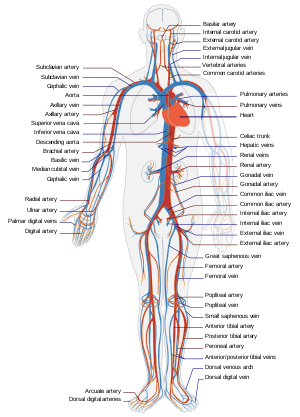Circulatory collapse
A circulatory collapse is defined as a general or specific failure of the circulation, either cardiac or peripheral in nature. Although the mechanisms, causes and clinical syndromes are different, the pathogenesis is the same—the circulatory system fails to maintain the supply of oxygen and other nutrients to the tissues and to remove the carbon dioxide and other metabolites from them. The failure may be hypovolemic or distributive.
| Cardiovascular collapse | |
|---|---|
 | |
| Circulatory system |
A common cause of this could be shock[1] or trauma from injury or surgery.[2]
Types
A general failure is one that occurs across a wide range of locations in the body, such as systemic shock after the loss of a large amount of blood collapsing all the circulatory systems in the legs. A specific failure can be traced to a particular point, such as a clot.
Cardiac circulatory collapse affects the vessels of the heart such as the aorta and is almost always fatal. It is sometimes referred to as "acute" circulatory failure.
Peripheral circulatory collapse involves outlying arteries and veins in the body and can result in gangrene, organ failure or other serious complications. This form is sometimes called peripheral vascular failure, shock or peripheral vascular shutdown.
A milder or preliminary form of circulatory collapse is circulatory insufficiency.
Causes
A very large range of medical conditions can cause circulatory collapse.[3] These include, but are not limited to:
- Surgery, particularly on patients who have lost blood.
- Blood clots, including the use of some platelet-activating factor drugs in some animals and humans
- Dengue fever
- Severe dehydration
- Shock (including, among other types, many cases of cardiogenic shock- e.g., after a myocardial infarction or during heart failure; distributive shock, hypovolemic shock, resulting from large blood loss; and severe cases of septic shock)
- Heart disease (myocardial infarction- heart attack; acute or chronic congestive or other heart failure, ruptured or dissecting aneurysms; large, especially hemorrhagic, stroke; some untreated congenital heart defects; failed heart transplant)
- Superior mesenteric artery syndrome
- Drugs that affect blood pressure
- Drinking seawater[4]
- As a complication of dialysis
- Intoxicative inhalants[5]
Effects
The effects of a circulatory collapse vary based on the type of collapse it is. Peripheral collapses usually involve abnormally low blood pressure and result in collapsed arteries and/or veins, leading to oxygen deprivation to tissues, organs, and limbs.
Acute collapse can result from heart failure causing the primary vessels of the heart to collapse, perhaps combined with cardiac arrest.
Diagnosis
Treatment
References
- http://www.spaceref.com/iss/medical/4044.shock.circ.collapse.em.pdf
- http://www.plosone.org/article/info:doi%2F10.1371%2Fjournal.pone.0001605#pone.0001605-Heckbert1
- Oxford Textbook of Medicine: 3-Volume Set By David A. Warrell, Timothy M. Cox, John D. Firth, Edward J. Benz, Sir David Weatherall Contributor David A. Warrell, Timothy M. Cox, John D. Firth, Edward J. Benz, Sir David Weatherall Published by Oxford University Press, 2005 ISBN 0-19-857015-5, 978-0-19-857015-8
- Germann, W. J., Stanfield, C. L. 2005. Principles of Human Physiology, second ed. Pearson Education, Inc., CA, pp. 619.
- Ghuran, A (2000). "Recreational drug misuse: issues for the cardiologist". Heart. 83 (6): 627–633. doi:10.1136/heart.83.6.627. ISSN 0007-0769. PMC 1760847.